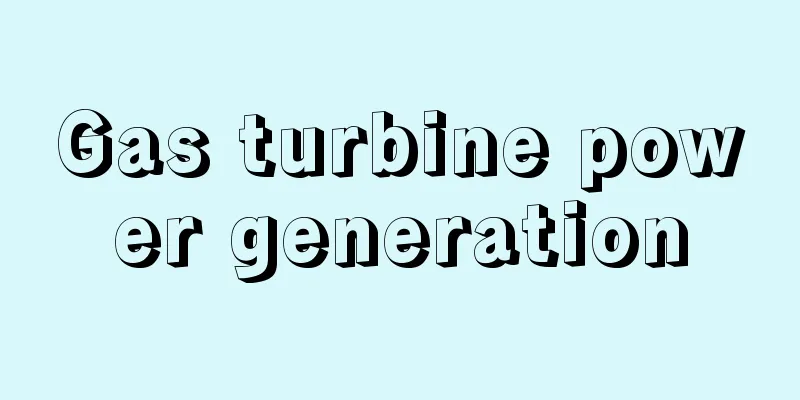Gas turbine power generation

|
A power generation method that uses a gas turbine as a prime mover. There are those with large capacities of hundreds of thousands of kilowatts that are combined with steam power generation, such as Advanced Combined Cycle (ACC) power generation, to achieve high efficiency, and small ones of around 200 kilowatts or less called micro gas turbines. The principle is to generate electricity by directly connecting a generator to an aircraft gas turbine, so no cooling water is required, start-up and shutdown are quick, and output adjustment to the load is easy. Efficiency is achieved by increasing the temperature of the combustion gas, so those exceeding 1500°C have an efficiency of nearly 40%. Those of around 100,000 kilowatts are used during peak loads of power supply, as in-house power sources for large factories, and as emergency power sources. Because they were developed for aircraft, they are smaller and simpler in structure than steam power generation, have fewer auxiliary equipment, and take less time to build. In gas turbine power generation, the intake air is compressed to high pressure by an air compressor directly connected to the gas turbine, then sent to the combustor, where fuel oil (heavy oil, kerosene, etc.) is injected and burned. The compressed air flow is heated and enters the gas turbine, containing combustion gas, where it expands and rotates the turbine impeller. The exhaust gas is at a low pressure close to atmospheric pressure. Since the temperature of the exhaust gas is close to 600°C, it is not released into the atmosphere, but rather the exhaust gas is used to generate ACC power by combining it with steam power generation, which can provide an additional 20% of electricity. For this reason, it is thought that this will become the mainstream of thermal power plants to be built in the future. Even with small-capacity micro gas turbine power generation, the exhaust gas temperature is high at around 300°C, so hot water can be extracted using a heat exchanger. A cogeneration system that uses this hot water is promising as a distributed power source for a microgrid (a small-scale power supply network closely tied to a local area). By utilizing relatively low-temperature heat, the overall thermal efficiency can be increased to around 80%. [Ryuichi Shimada] [Reference] | | | |Source: Shogakukan Encyclopedia Nipponica About Encyclopedia Nipponica Information | Legend |
|
ガスタービンを原動機とする発電方式。改良型複合サイクル(アドバンストコンバインドサイクルAdvanced Combined Cycle:ACC)発電のような蒸気発電と組み合わせて高効率にするために数十万キロワット級に大容量化されたものと、マイクロガスタービンとよばれる200キロワット程度以下の小型のものがある。原理は航空機用のガスタービンに発電機を直結し発電する形なので、冷却水が不要で起動・停止が早く、負荷との出力調整も容易である。効率は燃焼ガスの温度を高くすることで得られるので1500℃を超えるものは40%近い。10万キロワット程度のものは、電力供給のピーク負荷時や大工場の所内電源、非常用電源などに用いられている。航空機用に発展してきた関係で汽力発電に比べると小型で構造が簡単で補機が少なく、建設期間も短い。 ガスタービン発電では、吸気された空気がガスタービン直結の空気圧縮機により高い圧力に圧縮されてから燃焼器に送られ、燃料油(重油、灯油など)の噴射を受けて燃焼する。圧縮空気流は加熱されて燃焼ガスを含んでガスタービンに入り、膨張してタービンの羽根車を回転させる。排気は大気圧に近い程度の低圧となる。排ガスの温度は600℃近くあるのでそれを大気中に放出せず、その排ガスを利用して、蒸気発電と結合させることによりACC発電を行えばさらに20%程度の電力を得ることができる。そのため、これから建設される火力発電の主流になると考えられている。 小容量のマイクロガスタービン発電でも排ガス温度は300℃付近と高いので、熱交換機で温水を取り出すことができる。この温水を利用する熱電併給(コ・ジェネレーション)システムはマイクログリッド(地域に密着した小規模電力供給網)の分散電源として有望である。比較的低温の熱まで利用する結果、総合熱効率は80%程度まで上がる可能性がある。 [嶋田隆一] [参照項目] | | | |出典 小学館 日本大百科全書(ニッポニカ)日本大百科全書(ニッポニカ)について 情報 | 凡例 |
Recommend
Dolomitization - Dolomitization
...Also called dolomitization. It is the phenomen...
Hydroxysuccinic acid
...A type of hydroxy acid (oxycarboxylic acid), i...
Chemical Laser - Kagaku Laser
A laser uses the light emitted by creating a nega...
Wild Grape - Ampelopsis brevipedunculata var. maximowiczii
A perennial plant of the Vitaceae family. A vine c...
Petroleum resin
Naphtha is thermally cracked to obtain useful com...
dithyrambos
…Years of birth and death unknown. He created the...
Kappore
A folk song. In the late Edo period, in Edo, monk...
Panchatantra - Panchatantra (English spelling)
A collection of Sanskrit tales from ancient India...
Kasuri thread
…The etymology is from the Malay word mengikat, w...
rape
...In North America and Europe, the seeds are use...
《Ettuthai》 - Ettuthai
… [Masayuki Onishi] [Tamil Literature] The Dravid...
Asarum heterotropoides (English spelling)
… [Mitsuru Hotta]... *Some of the terminology tha...
Doan Thi Diem (English spelling)
…The author, who lived in an era when Vietnam was...
Hematopoietic drug
A drug that increases the number of blood cells, ...
Complex lipid
...These include fats, waxes, and sterol esters. ...



![Kyrenia [Mountains] - Kyrenia](/upload/images/67d0731c41f14.webp)





